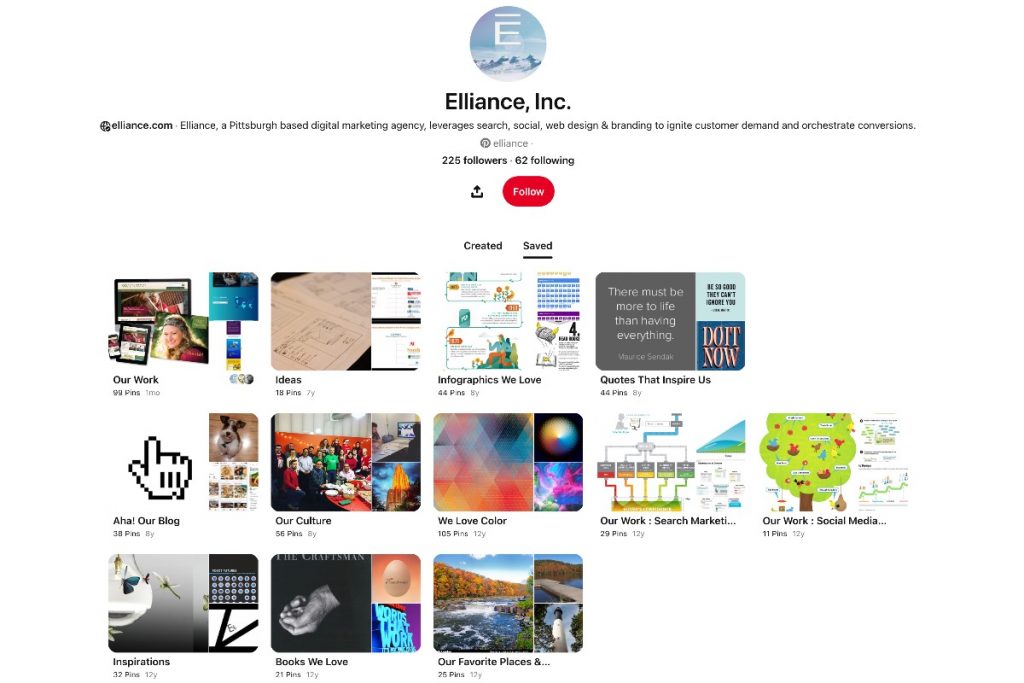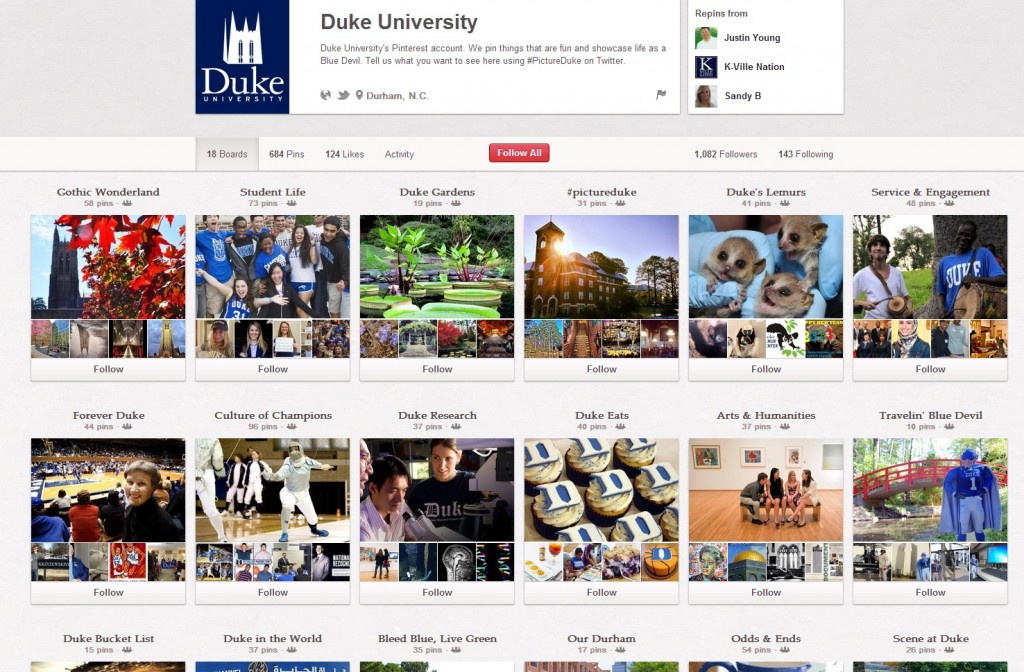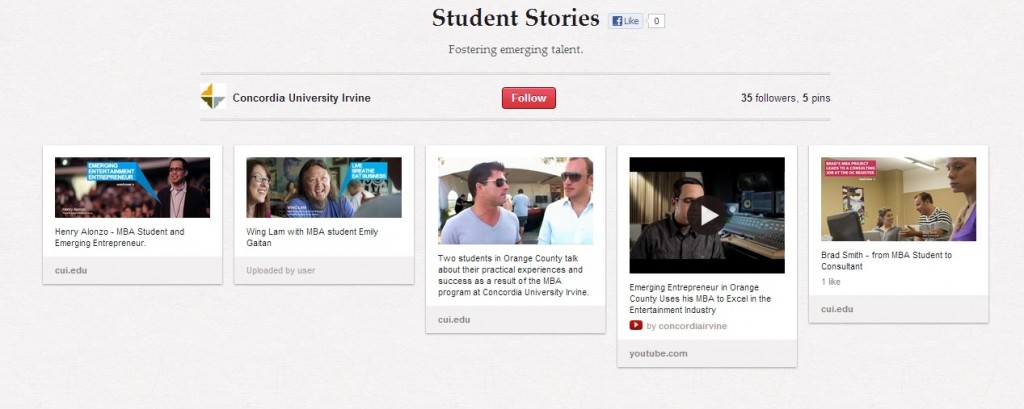| Apr 1, 2013
How Important is Pinterest to Higher Education Marketing?

Amy mentioned in her last post the strength of Pinterest as a marketing channel. Pinterest is now the third-largest social network behind only Facebook and Twitter. For marketers, Pinterest is one more channel in the marketing toolkit that we need to think (and worry) about. In the realm of the higher education marketing industry, Pinterest presents an interesting opportunity, which can help reach a completely different segment of your prospect population.
But how do you use Pinterest to give a sense of who you truly are as a brand? The first step is to figure out the core of your brand. The next step is to share that brand ideology, and that’s where Pinterest can be very powerful. Here are five things to keep in mind when sharing that ideology on Pinterest:
- Truly represent brand culture: Trying to choose which college to go to is a big decision. What a prospective student needs to feel is comfort with the brand, a feeling that says – ‘this is where I belong’. Creating ‘on-campus’ boards will help invoke those feelings. Boards about campus and location photos, on-campus events, and student stories all give a true sense of the brand.
- Tell “people” stories: Your people are your best asset, be it alumni, current students or faculty. Use their stories to attract similar people to the brand. Prospective students will connect with this human element. Some ways to represent people stories on your Pinterest channel could include creating an ‘alumni stories’ board or an ‘I Teach’ board for faculty members.
- Put your best face forward: Attract prospects with high quality images which truly show the strengths of your people, your campus and your city. Prospective students looking for a potential school might love one of your images and repin it on their boards. Make it look pretty: use good, high quality images.
- Use “all” visual content: Use images, videos, infographics or any other visual media which helps impart the personality of the brand. Use it to romance and engage your prospects.
- Represent thoughts and ideas inherent in the brand: There will be many issues that your brand supports. It could be service to the community, green living, environmental issues, etc. Bring those to the front. For example, if green living and sustainability is a part of the culture, create a board about that to represent that ideology.
Here are some examples of Pinterest profiles from the higher education industry which are worth noting:
Duke University’s Pinterest channel is very distinctly Duke. There is lightness and playfulness represented by the ‘Travelin’ Blue Devil’ board but at the same time there is a depth to the brand, communicated through the ‘Service & Engagement’ board. My personal favorite is the ‘Culture of Champions’ board. One can see at a glance where the strengths are.
The Concordia University Irvine ‘Student Stories’ board is very interesting in how they represent some of their student stories. They’ve used both images and videos which makes it very engaging to see how each student’s story is so different yet similar.
The Texas A&M Pinterest channel just exudes confidence and pride. Everything is “Aggie” centric. Who would not want to be a part of this group?
Ideally, these guidelines should be considered before starting your Pinterest initiative. Once things are in place, it becomes extremely challenging to make changes and turn things around. The strategy of what needs to go on the channel needs to be thought through with as much depth as any other marketing or branding decision.
Learn more about our higher education marketing services and social media services.
Amy mentioned in her last post [KJ1] the strength of Pinterest as a marketing channel.
[KJ1]Link here?
Amy mentioned in her last post the strength of Pinterest as a marketing channel. Pinterest is now the third-largest social network behind only Facebook and Twitter. For marketers, Pinterest is one more channel in the marketing toolkit that we need to think (and worry) about. In the realm of the higher education marketing industry, Pinterest presents an interesting opportunity, which can help reach a completely different segment of your prospect population.
But how do you use Pinterest to give a sense of who you truly are as a brand? The first step is to figure out the core of your brand. The next step is to share that brand ideology, and that’s where Pinterest can be very powerful. Here are five things to keep in mind when sharing that ideology on Pinterest:
1. Truly represent brand culture: Trying to choose which college to go to is a big decision. What a prospective student needs to feel is comfort with the brand, a feeling that says – ‘this is where I belong’. Creating ‘on-campus’ boards will help invoke those feelings. Boards about campus and location photos, on-campus events, and student stories all give a true sense of the brand.
2. Tell “people” stories: Your people are your best asset, be it alumni, current students or faculty. Use their stories to attract similar people to the brand. Prospective students will connect with this human element. Some ways to represent people stories on your Pinterest channel could include creating an ‘alumni stories’ board or an ‘I Teach’ board for faculty members.
3. Put your best face forward: Attract prospects with high quality images which truly show the strengths of your people, your campus and your city. Prospective students looking for a potential school might love one of your images and repin it on their boards. Make it look pretty: use good, high quality images.
4. Use “all” visual content: Use images, videos, infographics or any other visual media which helps impart the personality of the brand. Use it to romance and engage your prospects.
5. Represent thoughts and ideas inherent in the brand: There will be many issues that your brand supports. It could be service to the community, green living, environmental issues, etc. Bring those to the front. For example, if green living and sustainability is a part of the culture, create a board about that to represent that ideology.
Here are some examples of Pinterest profiles from the higher education industry which are worth noting:
Duke University’s Pinterest channel is very distinctly Duke. There is lightness and playfulness represented by the ‘Travelin’ Blue Devil’ board but at the same time there is a depth to the brand, communicated through the ‘Service & Engagement’ board. My personal favorite is the ‘Culture of Champions’ board. One can see at a glance where the strengths are.
— /* Style Definitions */ table.MsoNormalTable {mso-style-name:”Table Normal”; mso-tstyle-rowband-size:0; mso-tstyle-colband-size:0; mso-style-noshow:yes; mso-style-priority:99; mso-style-parent:””; mso-padding-alt:0in 5.4pt 0in 5.4pt; mso-para-margin-top:0in; mso-para-margin-right:0in; mso-para-margin-bottom:10.0pt; mso-para-margin-left:0in; line-height:115%; mso-pagination:widow-orphan; font-size:11.0pt; font-family:”Calibri”,”sans-serif”; mso-ascii-font-family:Calibri; mso-ascii-theme-font:minor-latin; mso-hansi-font-family:Calibri; mso-hansi-theme-font:minor-latin;} –>



